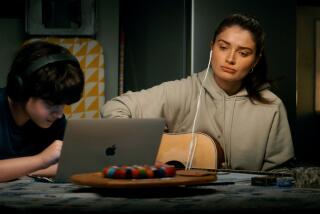JAZZ REVIEW : Despite Ill Winds, Trumpeter Carney Blows Well : A series of minor misfortunes before the set at Spaghettini with pianist Wayne White did not diminish the effect of the music.
- Share via
SEAL BEACH — To say that trumpeter Andrew Carney’s appearance Tuesday at Spaghettini came off without a hitch wouldn’t be honest. Murphy’s law may not have been in full effect (after all, not everything that could have gone wrong did), but Carney’s patience was sorely tested.
The 7:30 p.m. starting time found Carney noodling on the piano, waiting for his pianist, Wayne White. Carney’s drummer had canceled earlier. Lost somewhere between Woodland Hills and the Orange County line, White arrived eventually.
But before he did, the trumpeter--ever the professional--called another pianist who lived nearby. Of course by the time the sub had arrived, White was already at the keyboard.
In the hour before either accompanist showed, Carney took the time to pose for photos and talk. The Long Beach-based musician, who makes the bulk of his living doing session and other commercial work, chatted about the drawbacks of playing the club scene, then explained why he continues to do it.
“This is what being a jazz musician is all about,” he said, “playing out in front of an audience and getting a response.” Then, with keyboardist White in tow, he proceeded to do just that.
Oh, and one other thing: That Carney himself made the gig is a bit of a surprise. Three weeks ago, he had a non-malignant, “golf-ball sized” tumor removed from his neck, and he sported the scar to prove it. The doctors weren’t sure he’d be able to play after the operation. Luckily, he was.
In fact, if he hadn’t made modest mention of the surgery, one might not have been able to tell from his performance. Carney, who claims to practice six hours a day, seemed intent on showing that his chops were up, employing long passages of circular breathing, a technique that allows him to play seemingly unending phrases without stopping for breath.
It’s a neat little trick that more and more saxophonists are using, but few trumpeters are capable of.
While some use circular breathing merely for grandstanding (Kenny G wows his audiences by holding a single, sustained tone for nearly two minutes), Carney puts the technique to good use, continuing his narrative unbroken rather than drawing attention to the ploy.
Backed only by piano, he used these long passages as a means of creating dynamic tension, since there was no percussionist to raise the excitement level behind him.
*
Playing through a pickup microphone clipped to the bell of his horn, Carney applied an electronic echo effect that often gave his playing an eerie sense of deja vu. This made the open space he left between notes as important as the notes themselves, as what he just finished playing reverberated around him.
The technique was used to great effect in “Little Sunflower” as the trumpeter constructed swirling strings of notes. White, who frequently has worked with Carney, tracked chords and added bluesy fills, never stepping on the trumpeter’s toes while embellishing his playing.
The pianist’s own solos were expansive affairs, and he used a strangely tuned note on the Spaghettini piano as a touchstone, giving his playing a gospel-like feel. At other times, he was lush and romantic, giving his sound the same kind of mystical color that decorates the work of keyboardist Lonnie Liston Smith.
The two combined for a soulful version of “Autumn Leaves” that had both pensive and rhythmic airs. Carney kicked in his own synthesizer for programmed drums and horn section on an original ballad that, because of his clever computer work, sounded anything but canned.
The trumpeter also played a bass-toned solo on the synthesizer during “Bags Groove” that brought a hearty response from the uncharacteristically attentive Spaghettini crowd. All in all, Carney’s first set was worth the wait.
More to Read
The biggest entertainment stories
Get our big stories about Hollywood, film, television, music, arts, culture and more right in your inbox as soon as they publish.
You may occasionally receive promotional content from the Los Angeles Times.









